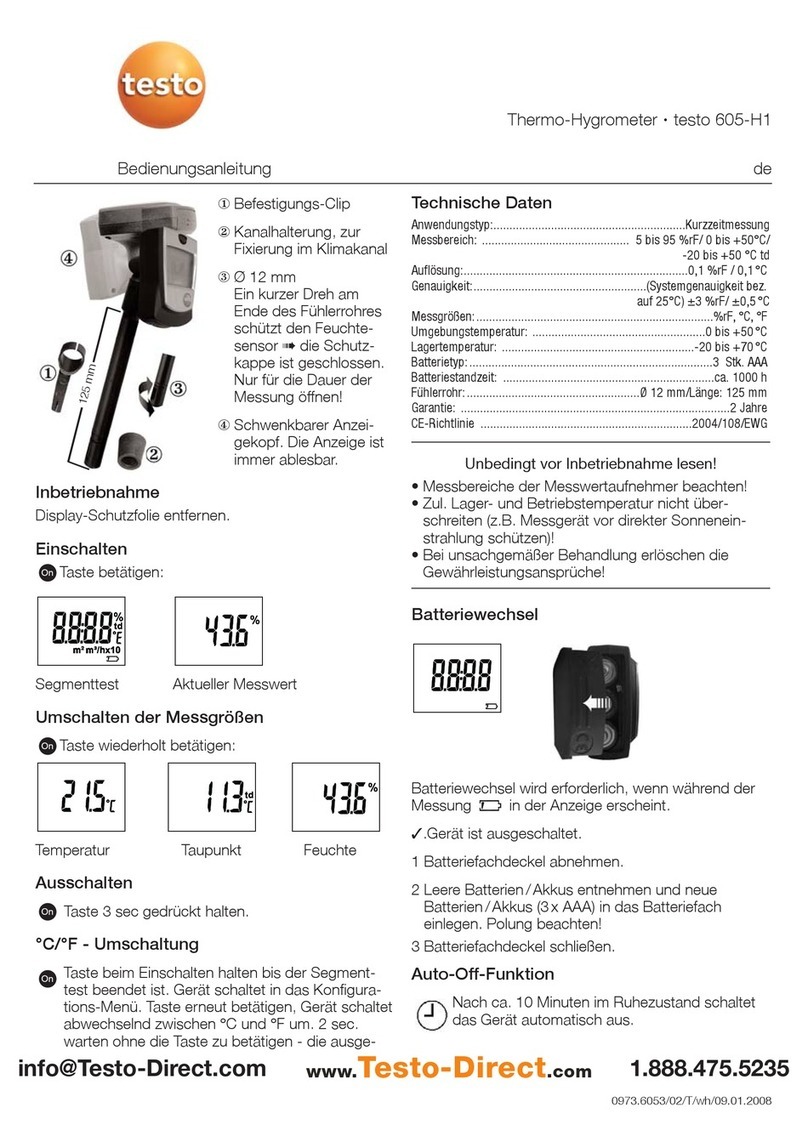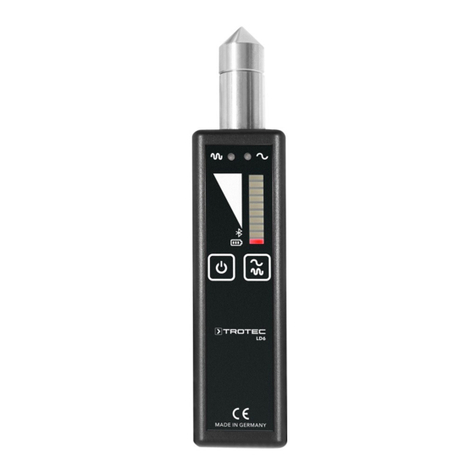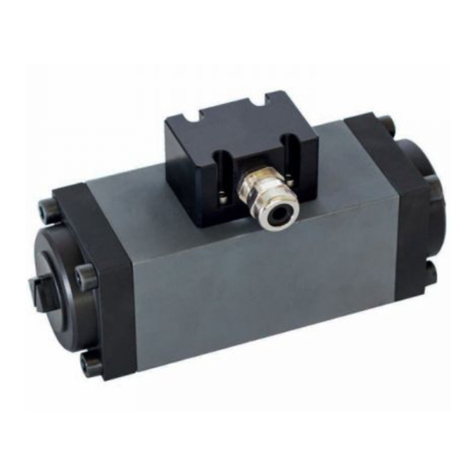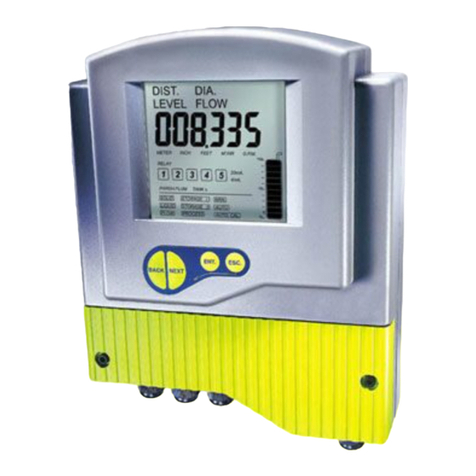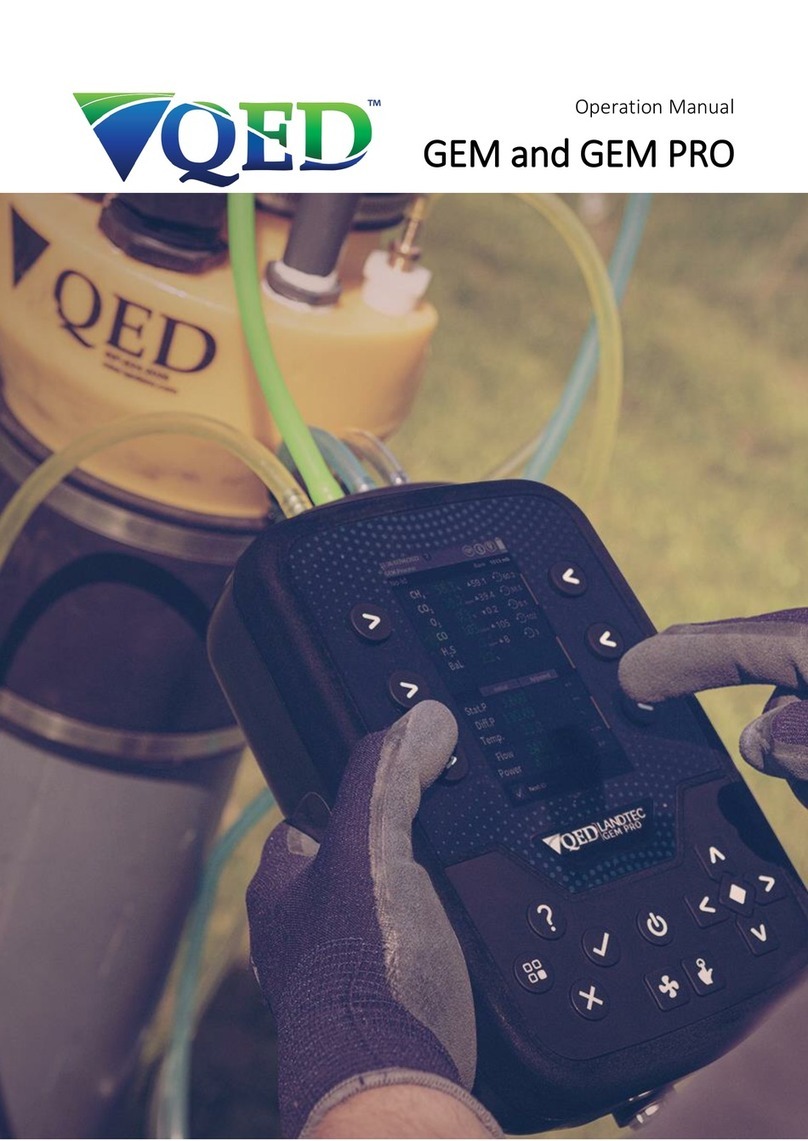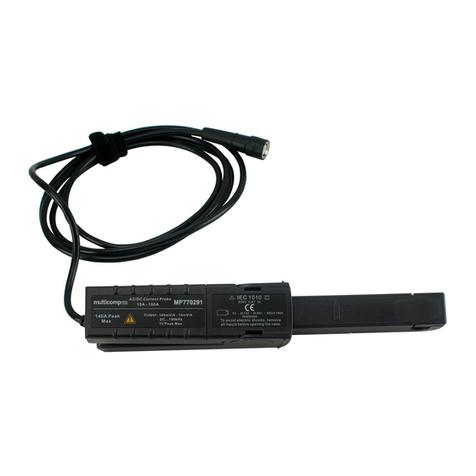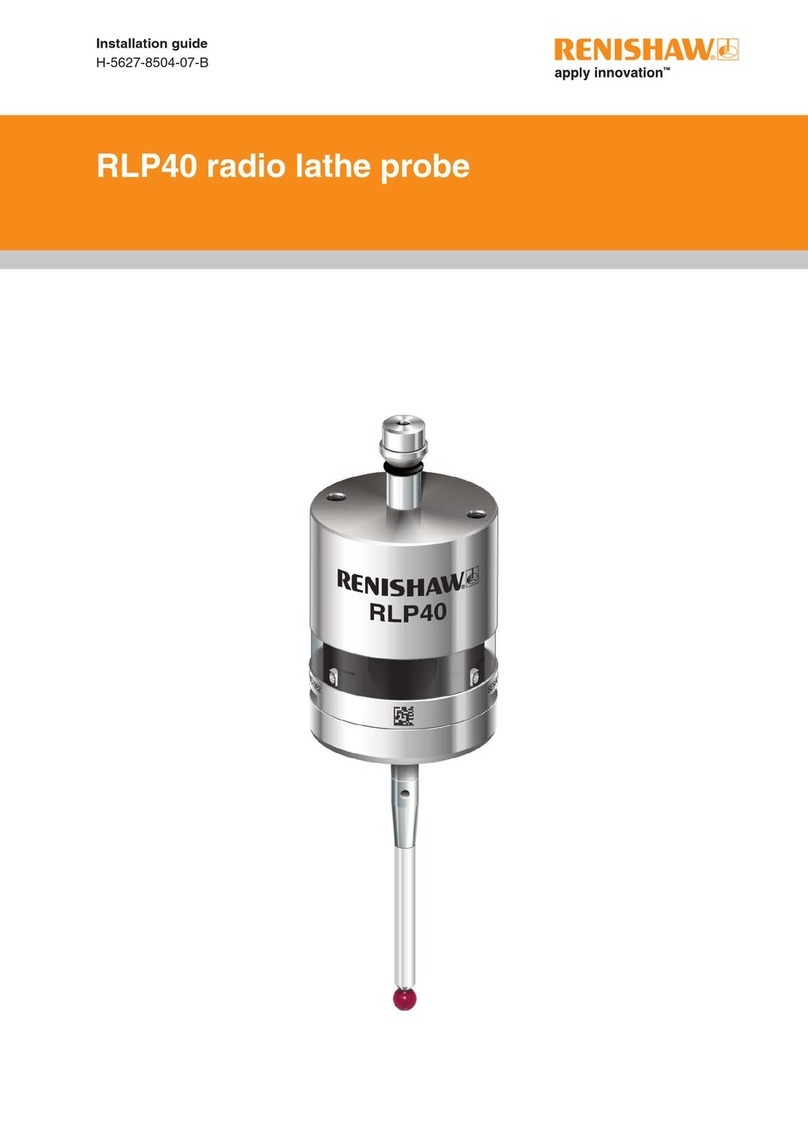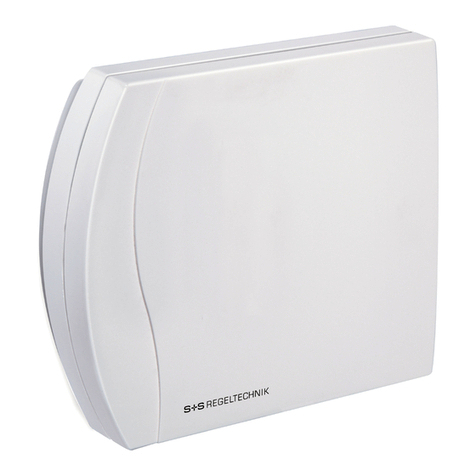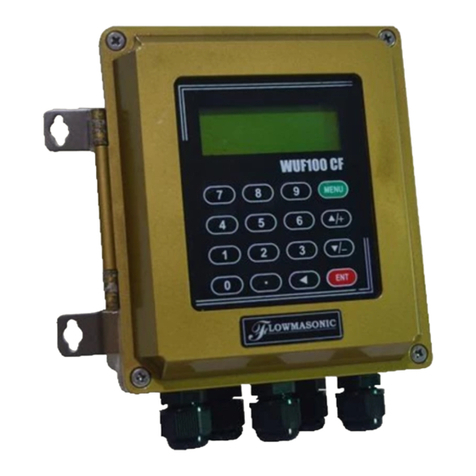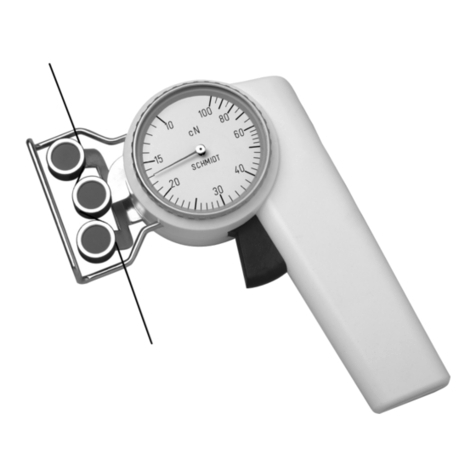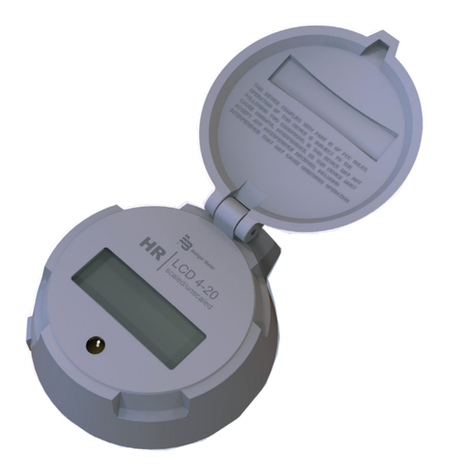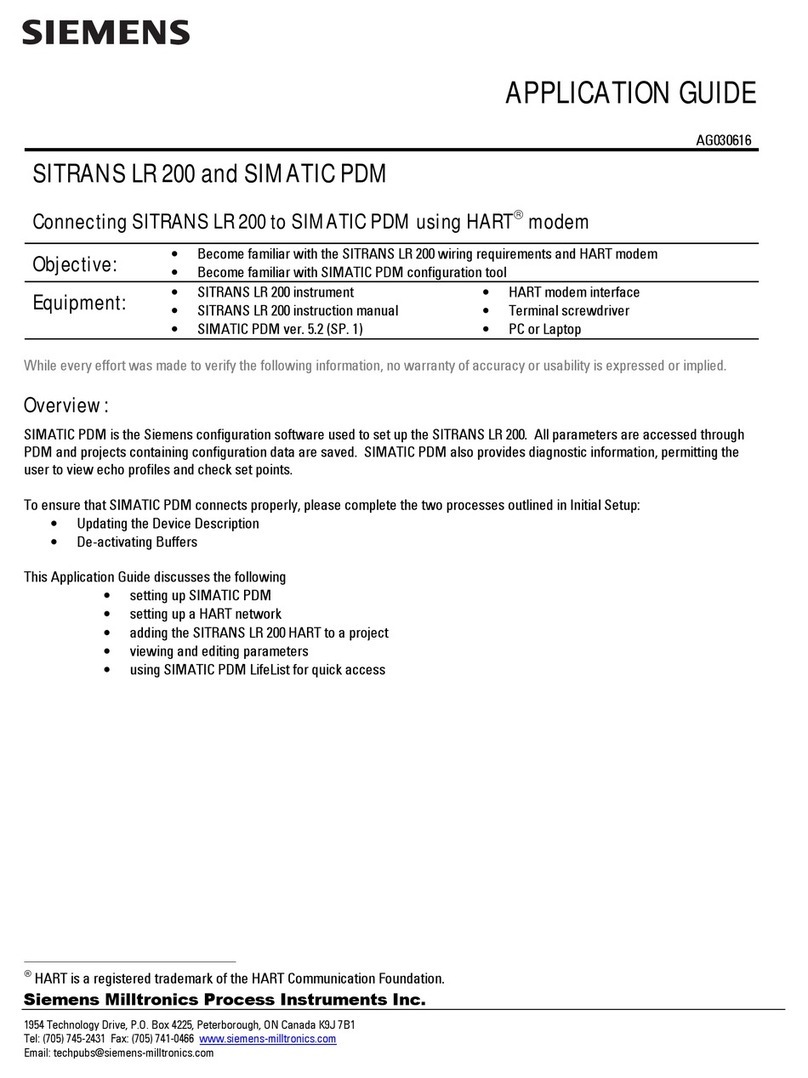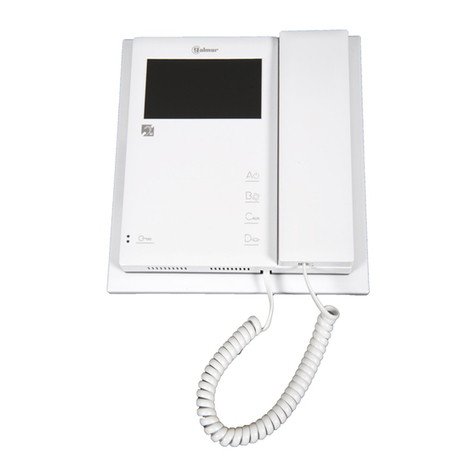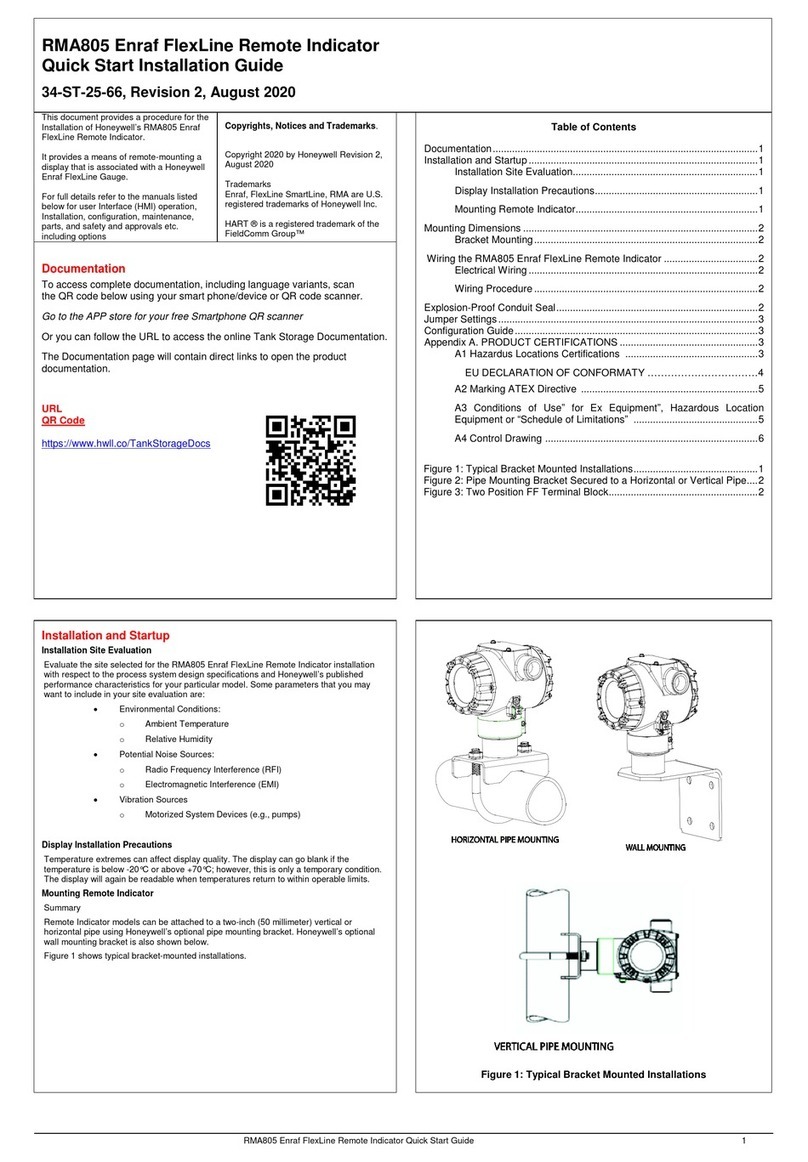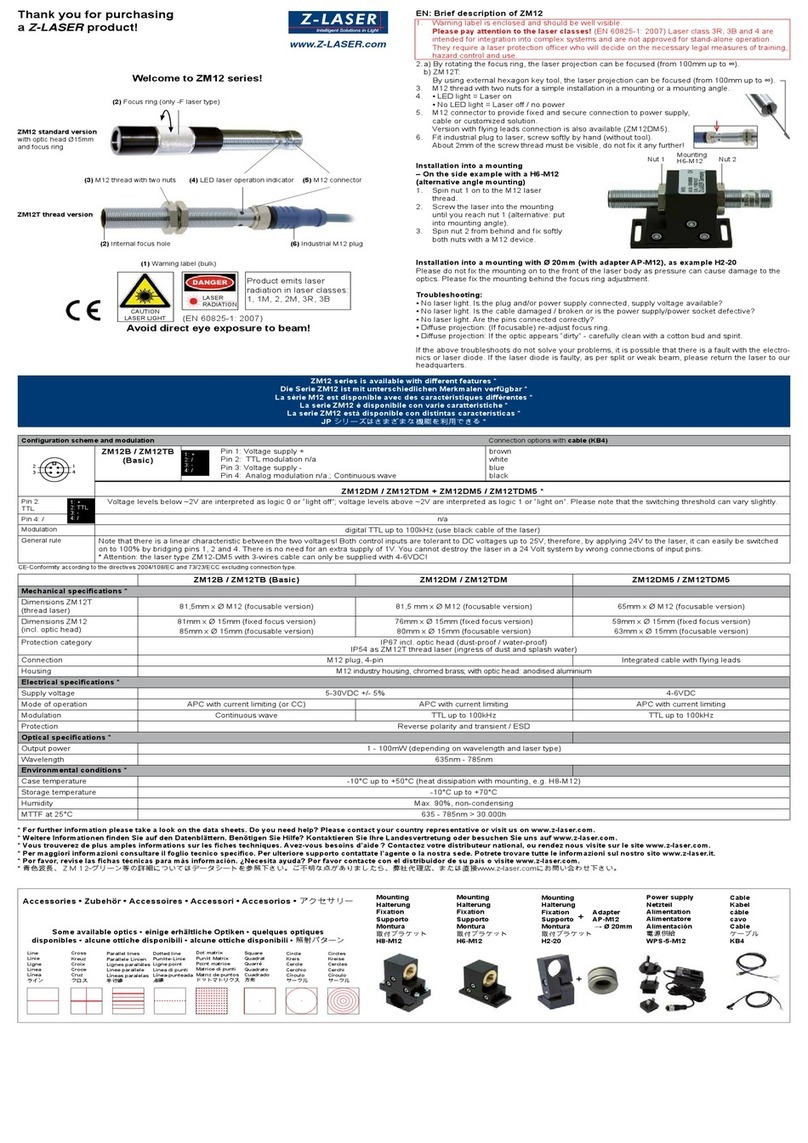Thermo GasTech HS-95 Manual

95 Series
Operator’s Guide
Personal Portable Gas Monitor
HS-95, CO-95, OX-95

ii 71-0011 — REV E
PROPRIETARY STATEMENT
Thermo GasTech owns proprietary rights in the information disclosed within. By
receiving this document, the recipient agrees that neither this document nor the
information disclosed within nor any part shall be reproduced or transferred to other
documents or used or disclosed to others for manufacturing or for any other purpose
except as specifically authorized in writing by Thermo GasTech.
COPYRIGHT STATEMENT
Information contained in this document is protected by copyright. No part of this
document may be photocopied, reproduced, or translated to another program or
system without prior written authorization from Thermo GasTech., © 2001,
Thermo GasTech.
TRADEMARK STATEMENT
Protected through use and/or registration in the United States and many foreign
countries are the trademarks and service marks of Thermo GasTech. The use of the
® symbol indicates registration in the United States only; registrations may not
have been issued at present in other countries. All other product names and logos
are trademarks of their respective owners.
GASTECH®is a trademark of Thermo GasTech and is registered with the U.S.
Patent and Trademark Office.
DISCLAIMER
Under no circumstances will Thermo GasTech be liable for any claims, losses, or
damages resulting from or arising out of the repair or modification of the equipment
by a party other than Thermo GasTech or its authorized service representatives, or
by operation or use of the equipment other than in accordance with the printed
instructions provided by Thermo GasTech or if the equipment has been improperly
maintained or subject to neglect or accident. Any of the foregoing will void the
warranty.
EXPORT STATEMENT
Export of the information and products in this manual from the U.S.A., or re-export
from another country, may require written authorization from the U.S. Department
of Commerce. Printed in the U.S.A.
REVISIONS TO MANUAL
All information contained in this manual is believed to be true and correct at the
time of printing. However, as part of its continuing efforts to improve its products
and their documentation, Thermo GasTech reserves the right to make changes at
any time without notice. Any revised copies of this manual can be obtained by
writing Thermo GasTech.

71-0011— REV E iii
WARNING
NOTATION CONVENTIONS
Notices are used in this operator’s guide to alert you to hazardous
conditions to person or instrument and to notify you of additional
information. This operator’s guide uses the following notices:
WARNING
Notifies you of potential danger of personal injury.
CAUTION
Notifies you of potential damage to equipment.
NOTE
Notifies you of additional or critical information.
T
HIS
INSTRUMENT
IS
DESIGNED
TO
DETECT
ONE
OR
MORE
OF
THE
FOLLOWING
:
FLAMMABLE
VAPORS
,
OXYGEN
CONTENT
,
AND
/
OR
TOXIC
GAS
AND
TO
GIVE
WARNING
BEFORE
THEY
REACH
HARMFUL
CONDITIONS
.
IN
ORDER
TO
ENSURE
THAT
IT
WILL
WARN
OF
DANGEROUS
CONCENTRATIONS
,
IT
IS
ESSENTIAL
THAT
THE
INSTRUCTIONS
IN
THIS
MANUAL
,
PARTICULARLY
THOSE
CONCERNING
START
UP
,
OPERATION
,
CALIBRATION
,
AND
MAINTENANCE
,
BE
READ
,
UNDERSTOOD
,
AND
FOLLOWED
.

iv 71-0011 — REV E
SERVICE POLICY
Thermo GasTech maintains an instrument service facility at the
factory as well as authorized service facilities around the world.
Shouldyourinstrumentrequireservice,youmaycontactustollfree
at1-877-GASTECH(427-8324)forUSonlyor1-510-745-8700,
orvisitourwebsitewww.thermogastech.comforauthorizedservice
locations.
For warranty ornon-warranty repairs,call us to complete a Return
Material Authorization (RMA) form, obtain billing and shipping
informationandtellusthenatureoftheproblem.Fornon-warranty
repairs, you will need to provide a purchase order number. If you
needtosetalimittotherepairscosts,statea“NottoExceed”figure.
If you need a quotation before you can authorized the repair costs,
so state, but understand this will incur additional costs and may
delay processing of the repair.
Youmaysendtheunit,prepaid,to:ThermoGasTech,8407Central
Ave., Newark, CA 94560-3431, Attn.: Service Department.
EnclosethecopyoftheRMA(ReturnMaterialAuthorization)that
was previously faxed to you. Pack the instrument and all its
accessories (preferably in its original packing) and any special
instructions.
Repairs are warranted for 90 days from the date of shipment.
Sensors have individual warranties.
NOTE
Thermo GasTech assumes no liability for work performed by
unauthorized service facilities.

71-0011— REV E v
WARRANTY STATEMENT
Thermo GasTech (the “Company”) warrants that the Products will
operate substantially in conformance with the Company’s published
specifications, when subjected to normal, proper, and intended usage by
properly trained personnel, for a period of one (1) year after shipment to
Customer (the “Warranty Period”). The Company agrees during the Warranty
Period, provided it is promptly notified in writing upon the discovery of any
defect and further provided that all costs of returning the defective Products to
the Company are prepaid by Customer, to repair or replace, at the Company’s
option, defective products so as to cause the same to operate in substantial
conformance with said specifications. Replacement parts may be new or
refurbished, at the election of the Company. All replaced parts shall become
the property of the Company.
Lamps, pump diaphragms/valves, batteries, fuses, bulbs, and other expendable
items are expressly excluded from the warranty.
The Company’s sole liability with respect to equipment, materials, parts, or
software furnished to the Company by third party suppliers shall be limited to
the assignment by the Company to Customer of any such third-party
supplier’s warranty, to the extent the same is assignable. In no event shall the
Company have any obligation to make repairs, replacements, or corrections
required, in whole or in part, as the result of (i) normal wear and tear, (ii)
accident, disaster, or event of force majeure, (iii) misuse, fault, or negligence
of or by Customer, (iv) use of the Products in a manner for which they were
not designed, (v) causes external to the Products such as, but not limited to,
power failure or electrical power surges, or (vi) use of the Products in
combination with equipment or software not supplied by the Company.
ANY INSTALLATION, MAINTENANCE, REPAIR, SERVICE,
RELOCATION, OR ALTERATION TO OR OF, OR OTHER TAMPERING
WITH, THE PRODUCTS PERFORMED BY ANY PERSON OR ENTITY
OTHER THAN THE COMPANY WITHOUT THE COMPANY’S PRIOR
WRITTEN APPROVAL, OR ANY USE OF REPLACEMENT PARTS NOT
SUPPLIED BY THE COMPANY, SHALL IMMEDIATELY VOID AND
CANCEL ALL WARRANTIES WITH RESPECT TO THE AFFECTED
PRODUCTS.
THE OBLIGATION TO REPAIR OR REPLACE A DEFECTIVE
PRODUCT SHALL BE THE SOLE REMEDY OF CUSTOMER IN THE
EVENT OF A DEFECTIVE PRODUCT. EXCEPT AS EXPRESSLY
PROVIDED IN THIS SECTION, THE COMPANY DISCLAIMS ALL
WARRANTIES, WHETHER EXPRESS OR IMPLIED, ORAL OR
WRITTEN, WITH RESPECT TO THE PRODUCTS, INCLUDING
WITHOUT LIMITATION ALL IMPLIED WARRANTIES OF
MERCHANTABILITY OR FITNESS FOR ANY PARTICULAR
PURPOSE. THE COMPANY DOES NOT WARRANT THAT THE
PRODUCTS ARE ERROR-FREE OR WILL ACCOMPLISH ANY
PARTICULAR RESULT.

vi 71-0011 — REV E

71-0011 — REV E vii
TABLE OF CONTENTS
Chapter 1 INTRODUCTION............................................. 1-1
OVERVIEW ............................................................ 1-1
DESCRIPTION........................................................ 1-1
SPECIFICATIONS..................................................1-2
Chapter 2 PHYSICAL DESCRIPTION........................... 2-1
OVERVIEW ............................................................ 2-1
PHYSICAL DESCRIPTION...................................2-1
Electronics Assembly .........................................2-3
Buzzer.................................................................2-4
Housing/Housing Gasket.................................... 2-4
Sensor ................................................................. 2-5
Battery Compartment.......................................... 2-5
Chapter 3 START UP & OPERATION ........................... 3-1
OVERVIEW ............................................................ 3-1
START UP...............................................................3-2
INSTRUMENT OPERATION ................................3-3
Alarm Indications ............................................... 3-3
Low or Dead Battery Indications........................3-4
Weak or Failed Sensor Indications.....................3-5
INTERFERENCE CHARTS ...................................3-6
OPTIONAL ACCESSORIES..................................3-8
Hand-aspirated Sample-draw Adapter................3-8
Earphone............................................................. 3-9
Vibrating Alarm.................................................. 3-9

viii 71-0011 — REV E
Chapter 4 CALIBRATION & MAINTENANCE............ 4-1
OVERVIEW ............................................................ 4-1
TEST KIT ................................................................4-2
Test Gas Cylinders..............................................4-2
H2S Regulator (for HS-95).................................4-2
Dispensing Valve (for CO-95 and OX-95)......... 4-2
Flowmeter (for CO-95 and OX-95).................... 4-3
Test Cup..............................................................4-3
Tubing................................................................. 4-3
Test Kit Instruction Sheet................................... 4-3
CALIBRATION PROCEDURES............................4-3
Preparing for Calibration (all models)................ 4-4
How to Use the Control Buttons.........................4-4
Calibration (HS-95, CO-95) ...............................4-6
Calibration (OX-95)............................................ 4-7
If Calibration Fails..............................................4-8
Switch to Default Zero (OX-95)......................... 4-9
Return to Normal Operation.............................4-10
MAINTENANCE ..................................................4-11
How to Open and Close Your Monitor............. 4-11
Troubleshooting Guide..................................... 4-12
Changing Alarm Setpoints................................4-13
Changing the Alarm Delay...............................4-14
Replacing Defective Components .................... 4-14
FRUs AND ACCESSORIES LIST........................4-19

71-0011 — REV E 1-1
INTRODUCTION
OVERVIEW
This Operator’s Guide provides information on the proper
set-up, use, calibration, and maintenance of the 95 Series of
single-gas monitoring instruments.
Chapter 2 contains a physical description of your monitor.
Instructions to use and interpret monitor readings are in
Chapter 3, Start Up and Operation. Chapter 4, Calibration
and Maintenance, also contains troubleshooting information
and a list of replacement part numbers.
DESCRIPTION
The 95 Series is a line of three personal, portable gas
monitors that each detect one gas. Each pocket-size
instrument detects either oxygen (O2), hydrogen sulfide
(H2S), or carbon monoxide (CO), and actuates an alarm to
alert you should the measured gas surpass the alarm setting.
Table 1-1 lists specifications for each model.
CHAPTER 1

95 Series Operators Guide
1-2 71-0011 — REV E
SPECIFICATIONS
** In range of ±2% O2from calibration point.
Specifications are subject to change without notice.
Table 1-1 95 Series Gas Monitor Specifications
Model Designation
(Gases Detected) OX-95 (0-30.0% O2in 0.1% increments)
HS-95 (0-100 ppm H2S in 1 ppm increments)
CO-95 (0-500 ppm CO in 1 ppm increments)
Detection Method Diffusion, electrochemical
Response Time
Accuracy
Repeatability
90% in 30 seconds
±5% of reading (±0.2% O2for OX-95**)
±3% of reading (±012% O2for OX-95**)
Gas Alarm Setpoints OX-95: 19.5% vol, decreasing, (programmable)
23.5% vol, increasing, (programmable)
HS-95: 10 ppm, and 15 ppm, (programmable)
CO-95: 25 ppm, 200 ppm, (programmable)
Gas Alarm Delay 3 sec. (programmable to 0, 1, 2, or 3 sec.)
Other Alarm Modes Weak or failed sensor, low or dead battery
Operator Controls - Powerswitch
- ZERO/- button
- SPAN/+ button
Dimensions
Weight 4.5 in. H x 2.5 in.W x 1.0 in. D
6.5 ounces
Battery Life
(approximate) Continuous, non-alarm operation per one 9V
alkaline battery:
OX-95: 3,200 hours
CO-95 and HS-95: 2,500 hours
Standard* and
Optional Accesso-
ries
Operator’s guide*, hand-aspirated sample-draw
adapter, earphone, test kits, vibrating alarm,
*strap.
Operating Tempera-
ture and Humidity -4º F (-20º C) to 113º F (45º C)
0-95% relative humidity (RH), non-condensing
Regulatory
Approvals UL classified; CSA classified
Class I, Division 1, Groups A, B, C, and D
DEMKO EEx ia IIB T2

71-0011 — REV E 2-1
PHYSICAL
DESCRIPTION
OVERVIEW
This chapter describes the physical components of your
95 Series gas monitor. For purposes of identification throughout
this guide, the monitor is described as having front and rear
housing halves, as shown in Figure 2-1.
PHYSICAL DESCRIPTION
To open your monitor, loosen the two captive screws on the rear
cover, then separate the two halves.
The components identified in Figure 2-1 are described in this
chapter. The field replaceable units (FRUs) include the housing
gasket, sensor, and battery.
CHAPTER 2

95 Series Operator’s Guide
2-2 71-0011 — REV E
Figure 2-1 Components of the 95 Series Gas Monitor
(Hydrophobic
membrane
behind grille) Sensor Port Buzzer Port
FRONT HOUSING
HOUSING GASKET
Operator Controls Cover
Earphone Jack Cover
ELECTRONICS ASSEMBLY:
Display Board
Display Cable
Main Board
Buzzer
Battery
Compartment
REAR HOUSING
Earphone Jack
Span Button
Power Switch
Zero Button
Plug-in
Sensor
LCD

Physical Description
71-0011 — REV E 2-3
Electronics Assembly
The electronics assembly consists of the main board, operator
controls (power switch, buttons, and earphone jack), display
board with liquid crystal display (LCD), and the display cable. If
any of these components fail, contact the factory for repair.
Main Board
All buttons and operator controls are part of the main board.
Control circuitry for other components is also located on the
main board.
ZERO/- and SPAN/+ Buttons
The ZERO/- button alone is used to zero the sensor and decrease
parameter settings. The SPAN/+ button alone is used to set
sensor span and increase parameter settings.
The ZERO/- and SPAN/+ buttons are pressed together to select
setting modes.
Power Switch
Set to the left position (toward the sensor) to turn the instrument
on. Set to the right position (away from the sensor) to turn the
instrument off.
Earphone/Vibrating Alarm Jack
The earphone or vibrating alarm accessory is connected to this
jack.

95 Series Operator’s Guide
2-4 71-0011 — REV E
Display Board/Display Cable
The display board is attached to the main board by a
nondetachable ribbon cable.
Liquid Crystal Display (LCD)
The LCD panel is visible through the window in the top of the
housing. A red LED is visible through the display panel as a
visual indication of alarm conditions. Display readings are
described in Chapter 3.
Buzzer
The buzzer is mounted on the main board.
Housing/Housing Gasket
The instrument housing is a two-piece plastic case held together
by two captive screws. A mylar gasket covers the operator
controls to keep water and dust away from the internal
components. The case is sealed using a detachable rubber gasket
and two flaps to protect the operator controls and earphone/
vibrating alarm jack.
The letters Z, P, and S on the inside of the flap identify the
position of the ZERO/- button, the power switch, and the SPAN/+
button, respectively. The arrow next to the P indicates the
direction to move the power switch to turn the instrument on and
off.

Physical Description
71-0011 — REV E 2-5
Sensor
Each model has a dedicated, detachable sensor that plugs into the
main board. Ahydrophobic (waterproof) membrane on the inside
of the case sensor opening is held down by a gasket. The
membrane permits diffusion of the surrounding atmosphere to
the sensor.
When sufficiently exposed to the target gas, the electrical output
of the sensor causes a reading on the display. Readings are in
parts per million (PPM) for H2S and CO, or percent (%) by
volume for O2.
Battery Compartment
The battery compartment houses a standard 9V alkaline battery.

95 Series Operator’s Guide
2-6 71-0011 — REV E

71-0011 — REV E 3-1
START UP &
OPERATION
OVERVIEW
This chapter describes the normal operation of your 95 Series gas
monitor, and how to respond to abnormal operation. Normal
operation is any time that start up has been completed, and the
monitor is not indicating an alarm, fault, or low battery condition.
This chapter also contains interference charts listing other gases
that can affect the sensor in the HS-95 or CO-95 monitor, and
procedures to use the optional accessories available for your
monitor.
CHAPTER 3

95 Series Operator’s Guide
3-2 71-0011 — REV E
START UP
Perform the following steps to start up your monitor. Refer to
Figure 2-1 as needed.
CAUTION
Perform start up only in a fresh air environment.
1. Flip open the housing gasket flap that covers the operator
controls, and move the power switch toward the sensor to
turn the monitor on. The unit should sound a single audible
tone, and display the installed version of software. A
number will then be displayed. Allow a few seconds for the
reading to stabilize, then check the display. If your HS-95 or
CO-95 shows a reading of 0 PPM, or your OX-95 a reading
of 20.9%, proceed to Step 4. If the reading is anything other
than this, perform Step 2 or 3, as appropriate.
2. Zero the HS-95 or CO-95 by pressing the ZERO/- button
until the PASS message appears (about 5 seconds).
3. Span the OX-95 by pressing the SPAN/+button until the
PASS message appears (about 5 seconds).
4. Close the operator controls flap. Your monitor is ready for
use.

Start Up & Operation
71-0011 — REV E 3-3
INSTRUMENT OPERATION
In normal operation, your instrument monitors the environment
and displays the current gas concentration. The instrument
displays alarms to indicate gas concentrations outside preset
limits. Low and dead battery as well as weak and failed sensor
conditions are also indicated.
NOTE
Momentary small negative gas readings are not abnormal with
the HS-95 and the CO-95. The instrument automatically corrects
itself.
Alarm Indications
When a gas concentration reaches the alarm setpoint, the alarm is
indicated by the buzzer pulsing, the red alarm light flashing, and
the gas reading blinking, all in unison. For the HS-95 and the
CO-95, the gas alarm is a pulsing audible tone with a blinking
reading for the low level alarm, and a steady audible tone with
pulsing display for the high level alarm. For the OX-95, you can
tell whether the alarm is a high or low alarm by the gas reading.
A high O2alarm shows a reading above the high setpoint, and is
signified by a pulsing audible tone. A low O2alarm shows a
reading below the low setpoint, and is signified by a steady
audible tone.
NOTE
Preset alarm setpoints conform to current OSHA standards, but
can be adjusted. See Chapter 4 for alarm adjust procedures.

95 Series Operator’s Guide
3-4 71-0011 — REV E
Recommended Action:
When an alarm occurs, follow the established procedure for an
alarm condition. If no procedure is in place, please establish one
that is appropriate for your application.
The alarm circuit is self-resetting. When the instrument is moved
from the suspect environment, the alarm ceases, and the
instrument returns to normal operation. However, this does not
mean that the danger has passed.
Low or Dead Battery Indications
Low Battery: When your monitor senses that the battery has
approximately 8 hours remaining, the word LOBAT blinks on the
LCD. In addition, the buzzer emits a short chirp and the red
alarm light flashes every 30 seconds.
Dead Battery: When the battery is past the point of useful
operation, LOBAT appears steadily on the LCD. In addition, the
buzzer sounds continuously and the red alarm light is on steady.
When these indications occur, the instrument is not operable.
Recommended Action:
Replace a dead battery immediately or a low battery as soon as
possible, following the procedure in Chapter 4.
Table of contents
